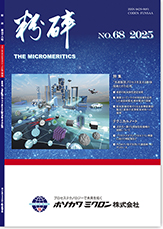- |<
- <
- 1
- >
- >|
-
2025Volume 68 Article ID: 2025001
Published: December 15, 2024
Released on J-STAGE: December 15, 2024
Download PDF (3034K)
-
2025Volume 68 Article ID: 2025002
Published: December 15, 2024
Released on J-STAGE: December 15, 2024
Download PDF (929K)
-
2025Volume 68 Article ID: 2025003
Published: December 15, 2024
Released on J-STAGE: December 15, 2024
Download PDF (7637K)
-
2025Volume 68 Pages 1-2
Published: December 15, 2024
Released on J-STAGE: December 15, 2024
Download PDF (6685K)
-
 2025Volume 68 Pages 3-8
2025Volume 68 Pages 3-8
Published: December 15, 2024
Released on J-STAGE: December 15, 2024
Editor's pickAs powder technology becomes more sophisticated, more precise particle characterization is required. This paper introduces Hosokawa Micron's Parshe Analyzer®, a dynamic image analyzer, and E-SPART Analyzer®, a particle size and charge measurement system. These instruments enable detailed analysis of particle shape and charge characteristics, and are expected to be a new evaluation tool to support the development of advanced powder technology.
Download PDF (10178K) -
2025Volume 68 Pages 9-20
Published: December 15, 2024
Released on J-STAGE: December 15, 2024
Download PDF (7030K) -
2025Volume 68 Pages 21-29
Published: December 15, 2024
Released on J-STAGE: December 15, 2024
Download PDF (5950K)
-
 2025Volume 68 Pages 30-36
2025Volume 68 Pages 30-36
Published: December 15, 2024
Released on J-STAGE: December 15, 2024
Editor's pickThis article explains the basic mixing mechanisms and design principles of the Nauta Mixer®, a representative batch-type mixer, providing an opportunity to better understand its principles and performance. Additionally, a low-floor model of the Nauta Mixer® is introduced, which addresses the challenges of installation in buildings with height limitations that previously made installation difficult
Download PDF (9002K) -
2025Volume 68 Pages 37-43
Published: December 15, 2024
Released on J-STAGE: December 15, 2024
Download PDF (8657K) -
 2025Volume 68 Pages 44-50
2025Volume 68 Pages 44-50
Published: December 15, 2024
Released on J-STAGE: December 15, 2024
Editor's pickThe "Solidaire" dryer, indirect heating dryer, a flagship product of our company, has been instrumental in drying a wide range of raw materials for many years. However, rather than resting on these achievements, our research and development team has been diligently working toward the development of next-generation indirect dryers. Through rigorous hypothesis modeling and practical testing, their dedication and passion for innovation are evident.
Download PDF (7623K) -
 2025Volume 68 Pages 51-56
2025Volume 68 Pages 51-56
Published: December 15, 2024
Released on J-STAGE: December 15, 2024
Editor's pickIn recent years, the development of machines for powder operations such as grinding, classification, mixing, drying, granulation, and measurement has reached a mature stage, making it increasingly difficult to create new products. Amid this challenge, new product development efforts are being advanced by combining traditional development methods with IoT and AI technologies, particularly through the use of digital twin technology. This report introduces the "Powder Tester™" as an example of such efforts.
Download PDF (7617K) -
 2025Volume 68 Pages 57-65
2025Volume 68 Pages 57-65
Published: December 15, 2024
Released on J-STAGE: December 15, 2024
Editor's pickThis study investigates the novel application of PLGA nanoparticles for periodontal disease prevention. IPMP-loaded PLGA nanoparticles exhibited significant biofilm inhibition and deep-layer penetration of active ingredients. Clinical trials demonstrated reductions in bacterial counts, subgingival bleeding, and halitosis, making them a promising candidate for advanced oral health solutions. The safety and low irritancy of IPMP further support its integration into daily dental care products. These findings provide a basis for developing novel periodontal care standards, with further studies needed to elucidate mechanisms and enable product commercialization.
Download PDF (5714K)
-
2025Volume 68 Pages 66-67
Published: December 15, 2024
Released on J-STAGE: December 15, 2024
Download PDF (5089K) -
2025Volume 68 Pages 68
Published: December 15, 2024
Released on J-STAGE: December 15, 2024
Download PDF (2353K) -
2025Volume 68 Pages 69
Published: December 15, 2024
Released on J-STAGE: December 15, 2024
Download PDF (6103K)
-
2025Volume 68 Pages 70-73
Published: December 15, 2024
Released on J-STAGE: December 15, 2024
Download PDF (7637K) -
2025Volume 68 Pages 74-75
Published: December 15, 2024
Released on J-STAGE: December 15, 2024
Download PDF (3781K) -
2025Volume 68 Pages 76-77
Published: December 15, 2024
Released on J-STAGE: December 15, 2024
Download PDF (6239K) -
2025Volume 68 Pages 78-79
Published: December 15, 2024
Released on J-STAGE: December 15, 2024
Download PDF (4258K) -
2025Volume 68 Pages 80-81
Published: December 15, 2024
Released on J-STAGE: December 15, 2024
Download PDF (3506K) -
2025Volume 68 Pages 82-83
Published: December 15, 2024
Released on J-STAGE: December 15, 2024
Download PDF (9040K) -
2025Volume 68 Pages 84-85
Published: December 15, 2024
Released on J-STAGE: December 15, 2024
Download PDF (3014K) -
2025Volume 68 Pages 86-87
Published: December 15, 2024
Released on J-STAGE: December 15, 2024
Download PDF (8967K) -
2025Volume 68 Pages 88-89
Published: December 15, 2024
Released on J-STAGE: December 15, 2024
Download PDF (5804K)
-
2025Volume 68 Pages 90-93
Published: December 15, 2024
Released on J-STAGE: December 15, 2024
Download PDF (6082K) -
2025Volume 68 Pages 94-98
Published: December 15, 2024
Released on J-STAGE: December 15, 2024
Download PDF (2301K) -
2025Volume 68 Pages 99-101
Published: December 15, 2024
Released on J-STAGE: December 15, 2024
Download PDF (4461K) -
2025Volume 68 Pages 102-107
Published: December 15, 2024
Released on J-STAGE: December 15, 2024
Download PDF (11930K) -
2025Volume 68 Pages 108
Published: December 15, 2024
Released on J-STAGE: December 15, 2024
Download PDF (1567K)
- |<
- <
- 1
- >
- >|
























